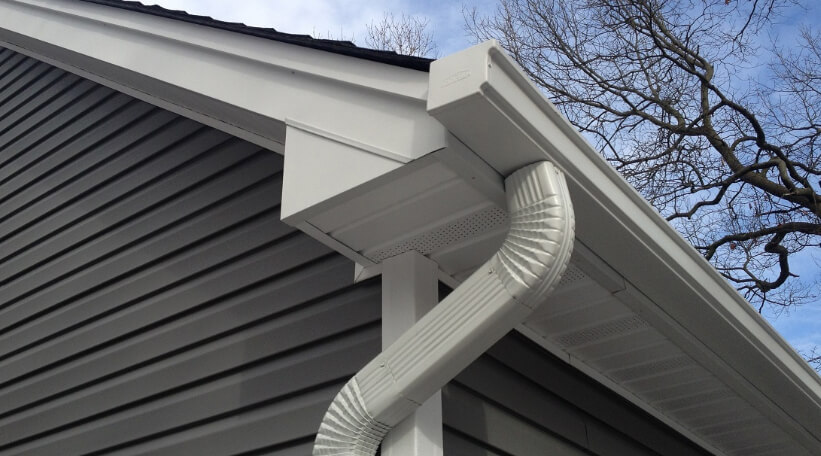Have you overlooked some exterior areas of your home that need attention?
By Tammy Adamson-McMullen
Summertime, naturally, is the biggest exterior painting season of the year. As you touch up around your home—or maybe completely repaint it—you may find that you’ve overlooked a few areas that need attention. Here’s a checklist to make sure you don’t miss any of these spots, as well as tips for doing the job right.
Eaves and Fascia Boards
Eaves help to divert water away from the house as it runs off the roof—a vital job but one that exposes eaves to beatings from Mother Nature.
If your eaves look grimy or moldy, you might be able to solve the problem by cleaning them with a TSP/water solution or commercial house wash. If so, voila! You’re done. However, if there are areas where the paint is cracked, peeled or blistered, you’ll need to remove the damaged paint with a power washer and/or scraper, depending on the size and scope of the problem. Afterward, sand the surface to a smooth finish and then apply the paint. If the boards are in very poor shape, you may need to replace them entirely. If so, prime and paint them as you did the original boards, allowing each coat to dry before applying the next.
If you recently painted your house, you might still want to take one last look at your eaves. Don’t only examine the top and sides but underneath the eaves, too. It’s not unusual for the underside of eaves to be overlooked in a repaint; in fact, there’s a chance that one or two sections might never have been painted at all! Tip: When painting the underside of eaves, be sure your exterior paint contains a mold inhibitor. This is always important—but especially in sun-starved areas where mold thrives.
Railings
Like eaves, railings can take a weather beating, especially on their horizontal surfaces. Handrails are usually the first to “go,” since they not only are horizontally positioned but usually are located outside the protection of porch and eaves. Look for grime and wear on these horizontal surfaces as well as undermined paint. If you find any problems, follow the directions outlined above for cleaning surfaces, removing paint, and repainting (or staining) these surfaces.
Additionally, look at the undersides of handrails and top and bottom rails to make sure they are adequately coated and free of mold. It’s especially easy to miss the underside of a top rail here and there when painting, especially the areas in between vertical rails and slats. If you discover untreated areas, take a small brush and roller and spot-paint what you missed. If some areas are just dirty or moldy, you might only need to spot-clean them with a sponge and TSP/water solution or detergent. Even though you typically don’t see the undersides of railings, it’s essential keep them clean and coated so that the rails hold up over time.
Foundations
Concrete foundations can fall prey to vegetation, ponding water, lawn mowers, weed wackers and other assailants. So it’s a good idea to give your foundation a regular “once-over,” to make sure it stays in the best shape possible.
If you do find problems, tackle them right away. First, cut back vegetation to move it off the foundation and out of your way. Use a pressure washer to remove grime, mold or damaged paint from the surface; the pressure washer will ensure that all of the pores in the concrete also are clean. If you discover holes, deep scratches or gouges, fill them with a patching compound after the surface is dry. This step is especially important to protect the integrity of your foundation. (If you find larger holes or cracks, you may have a more serious problem requiring professional attention.)
Once the compound has cured, apply a good-quality masonry sealer and two coats of the original paint, letting each coat dry before moving to the next. You can use a paint sprayer to apply the paint, but for added protection, you might want to roll the sprayed paint to force it into the concrete pores.
Gutters
Gutters are something you don’t normally notice until they fall into disrepair. If your gutters are in pretty good shape, you should still look carefully to make sure all of the sides are coated. Occasionally, the back side of downspouts are missed; and at the “right” viewing angle, these uncoated areas can diminish the curb appeal of your home.
It’s easy to spot-paint small areas, but what about larger areas? First, use a pressure washer to clean the gutters and remove any deteriorating paint. Next, hand-sand these areas, if needed, to make sure they’re smooth. Then brush on a direct-to-metal (DTM) bonding primer. These specialized primers are formulated to bind paint to metal and will ensure a longer-lasting and professional-looking job. Once the primer is dry, proceed with painting.
Accessories
How many times have you admired a newly painted home only to notice on second glance that the flower boxes, planters, and other exterior accessories were overlooked? Accessories make the outfit, and they also make the home! Most accessories are easy to paint in a day—or less if you use a custom spray paint to match your exterior color scheme. (Visit your local paint and decorating retailer to see if this service is offered.)
When painting flower boxes and planters, be sure to paint the insides as well as the bottoms. While these areas aren’t visible once the containers are filled with plants, they need protection from frequent waterings and run-off. The better coated they are, the better they will last over time—which, of course, is true of every single surface of your home.

 Interior Paints
Interior Paints Exterior Paints
Exterior Paints Primers
Primers Stains & Clears
Stains & Clears
 Paint Brushes
Paint Brushes Paint Roller
Paint Roller Paint Trays & Liners
Paint Trays & Liners
